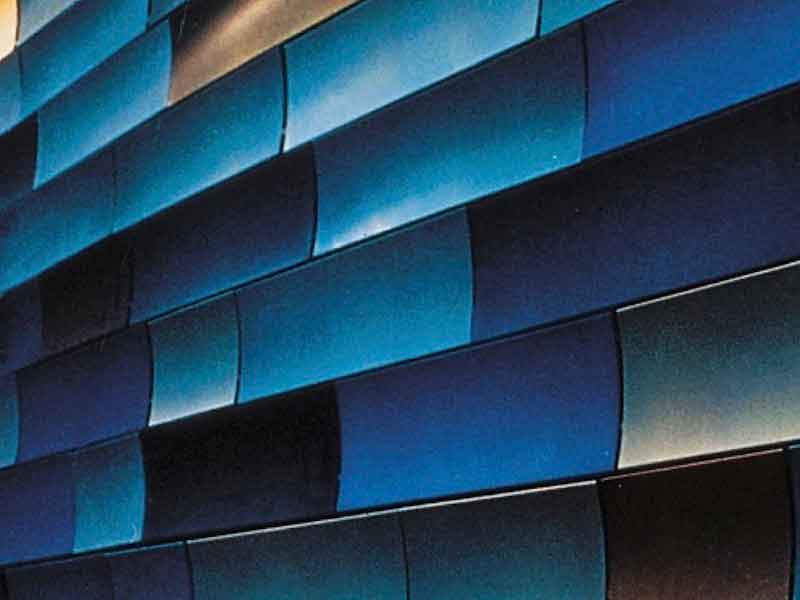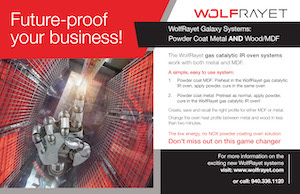Coloring aluminum by means of electrolytic 2-step has been widely practiced in North America since the late 1970s.
The technology found its roots in Japan and, as a result of the energy crises it was quickly developed in various regions of the world. The process is an energy efficient means of producing an aluminum finish that offers many of the benefits and few of the draw-backs of its predecessor integral coloring technologies. Unsurpassed light fastness, heat fastness, weather fastness, and chemical resilience are the reasons this finish has enjoyed wide acceptance in the architectural & special fields markets for over two decades.
 Mark JozefowiczImagine straws that are bundled together and positioned perpendicular to an aluminum surface. This model of an anodized coating goes far to illustrate how it is possible to impregnate metallic particles at the base of the pores (or straws) by means of a plating operation. Plating is essentially what 2-step coloring is. After the anodizing operation, the parts are immersed in a bath containing metal ions and electrical current is applied. The metal particles build up at the base of the pores and, depending on how long current is applied, the particles fill the pore to varying depths.
Mark JozefowiczImagine straws that are bundled together and positioned perpendicular to an aluminum surface. This model of an anodized coating goes far to illustrate how it is possible to impregnate metallic particles at the base of the pores (or straws) by means of a plating operation. Plating is essentially what 2-step coloring is. After the anodizing operation, the parts are immersed in a bath containing metal ions and electrical current is applied. The metal particles build up at the base of the pores and, depending on how long current is applied, the particles fill the pore to varying depths.
Unlike conventional plating operations, 2-step coloring uses AC rather than DC current. The reason for this is not fully understood but it is known that the use of AC current leads to fewer defects and makes the process more forgiving with respect to contamination.
Colors can vary with choice of metal, but are mainly dependent on the amount of metal that is deposited into the anodized coating. Coloring times for light colors can be as little as 30 seconds. Medium depth colors in a few minutes, and black in about 10 minutes. Almost all of the current world production of electrolytic 2- step is colored either bronze or black and use coloring baths based on either tin, nickel and, in a few cases, cobalt salts.
Four considerations should be taken into account by anyone planning to install electrolytic 2-step. These are product marketability, equipment investment, choice of chemistry and production details.
Marketing 2-Step
An assessment of marketability begins with an understanding of process limitations and cost. For instance, choice of alloy: The preferred alloys are taken from AA1XXX, AA3XXX, AA5XXX, and AA6XXX series. One cannot expect to achieve a reasonable finish on castings or AA2XXX series parts.
Compared to conventional clear, or dyed anodized parts, productivity of 2-step is quite low, and costs due to overhead are therefore substantially higher. As a comparison, a load will carry only 1/3 of the parts; at best 2/3 if a well-designed coloring tank is used. A 30-foot long, 6-foot deep tank will effectively color a load that is up to 500 ft2 in surface area. If the tank is wide enough to accommodate central electrodes, this maximum load size doubles to 1000 ft2.
The cost of the power and chemicals associated with the coloring step is usually insignificant at pennies per square foot of work processed.
Equipment
Equipment and its associated cost may be an important factor in determining justification for installing the process. In addition to a non-conductive coloring tank, at least one additional tank for rinsing is recommended. The typical process sequence would be: anodize, rinse, rinse, color, back to the 2nd anodize rinse, rinse, seal. To retro-fit an existing line, the question of space may come into play. It is important to note that the coloring tank contains electrodes along the sides, and possibly down the middle, therefore the width of this tank should be roughly the width of the anodize tank. The electrodes can be made of type 316 stainless steel, tin or graphite and should have a surface area that can vary from roughly 1:1 to 1:2 with that of the average load size.
A 60 Hz single phase AC power supply capable of delivering a peak current of 10 amps/ft2 and an average of 5 amps/ft2 at approximately 20 volts, must be located close to the coloring tank. A good quality power source is essential to a smooth running operation. Many people will argue that the most effective power supply combines a step down transformer with a motorized auto-transformer, that can increase the voltage at a steady rate. This type of power supply will supply a pure sine wave free of distortion. Solid state thyristor controlled units are less expensive and used by many, however the non-linear voltage ramp and less than perfect wave form has been known to cause problems – especially when an electronic component blows.
Over the years, process improvements have been promised by the advent of specialty power supplies. For instance, modulated systems, where the anodic and cathodic half waves can be individually controlled, have been shown to impact the process by speeding it up and improving control. Another system uses a 3- minute or longer DC treatment preceding the AC coloring step to improve on color uniformity by modifying the structure of the coating. Some enjoy the use of these specialty units; still others who own them opt to turn off these bells and whistles.
Surprisingly, getting the electrical current from the power supply to the tank can lead to many production headaches. The naturally occurring capacitance of the film, coupled with unwanted line impedance often results in a distorted electrical waveform and consequent color non-uniformity. Line impedance can be minimized by braiding the cables carrying the electrical current to the tank.
Other miscellaneous capital expenditures include the purchase of filtration equipment and may include a heat exchanger capable of maintaining the temperature of the bath between 65-75F. By their very nature, stannous ions are unstable. They readily oxidize to form stannic hydroxides, which subsequently drop out of solution as a fine yellow precipitate. It is recommended that continual filtration through a 10 micron filter be carried out on the production bath. Doing so will minimize the development of “fall out” smut on the finished part.
Chemistry
Once the equipment is in place, effective production of electrolytic 2-step begins with the choice of chemistry. In North America, the most commonly used chemistry is based on tin deposited from a stannous sulfate bath. Relative to nickel, tin baths provide the promise of increased productivity at lowest expense with minimal environmental impact. All tin baths are comprised of stannous sulfate and organic additives that are essential to the practicality of the process. Without the additives, color uniformity is sacrificed and the stability of the bath is severely reduced.
The concentration of dissolved tin is somewhat dependent on the choice of electrodes. If stainless steel or graphite is used, then all of the tin is supplied by the added stannous sulfate and normally the level in the bath is controlled within 15-20 g/l. If tin electrodes are used then the concentration of stannous sulfate is often kept near 12 g/l and roughly half of the tin used for coloring comes directly from the electrodes. In either case correct level of organic additives must be present to ensure color uniformity, and tin stability.
Tin electrodes offer the benefit of reduced chemical costs at the expense of higher capital costs. The process consumes the tin electrodes. Because of this, they must be regularly re-positioned in the tank to compensate for zones of higher and lower current flow. Typically tin electrodes are removed and recycled when their mass is reduced by about 60%. Stainless electrodes are less expensive up-front, last longer, but must be removed periodically for cleaning.
Chemicals are supplied as easy-to-use premixes, or as individual components. To prepare a bath, the former need only be diluted 1:10 with water containing 1% vol. sulfuric acid. Subsequent additions of the pre-mix are based on a simple titration for available stannous sulfate. This one component pre-mix system is the simplest, and most trouble free that the market has to offer. For those who prefer to add their stannous sulfate separately, the organic package can be added over-the-side at a ratio of approximately 1lb organic for every 3lbs stannous sulfate. This ratio changes to approximately 2:3, for those who use tin counter electrodes in their bath.
Production
Racking parts properly is far more important for electrolytic coloring than it is for clear anodizing. The first thing to keep in mind is that titanium jigs cannot be tolerated. The jigs must be made of aluminum and the preferred alloy is either AA6061 or AA6063 in the T6 temper.
Contacts must be secure. This is achieved by either clamping, spot welding, or by using a twist fixture technique. Spring clips can be used, but are normally only effective for half a dozen cycles before they must be discarded. This is because aluminum racks must be stripped prior to reuse and the clips soon lose their spring. A common problem is loss of electrical contact when the rack is being jostled while being transferred from the anodizing tank through the rinse steps to the coloring tank.
The third important consideration when racking is part spacing. The process involves electrical current flowing to the parts in a uniform way. Parts cannot shield one another from the electrodes. Practically this means spacing one part from another a distance no closer than P/5 where P is the perimeter of the part. It also means that the electrodes in the coloring tank can be separated by only one row of parts. If these rules are not followed, color uniformity will be impaired.
Once racked, the parts are anodized in the normal way. If the target color is black, than it is recommended that a minimum of 0.7 mil be built up during anodizing. This coating thickness is required to accommodate the quantity of tin deposited within the film. Without it, one runs the risk of over-filling the pores and a grayish smut resulting.
After anodizing, the parts are immersed in the coloring tank. The load must be allowed to soak for about one minute before the power is initiated. Without this soak, blotchy colors will result. The voltage should ramped up to operating voltage in 30 – 60 seconds. Doing so too quickly or too slowly may result in deeper or lighter colors around the periphery of the load. The operating voltage is typically 18-20 volts, normally about 1 volt lower than that used for anodizing. For very light shades, the value may be as little as 10 volts.
At the end of the coloring cycle, the power is discontinued and the load removed for a color check. This is commonly done on a section of the non-rinsed load that is dried with a paper towel and compared with light and dark color standards. Some lightening will occur during rinsing and sealing and this should be taken into account when the color check is being made. If additional color is required, the load is re-immersed in the coloring tank and the process is continued until the desired color is achieved.
Following the coloring step, the load is rinsed and sealed. Unlike dyed coatings, a nickel seal offers no benefit over a non-nickel seal. The most common seals used are either boiling water with a dispersent to control seal smut or a mid-temperature non-nickel seal.
In Summary
2-step electrolytic coloring of anodized aluminum is a mature technology, which has gained wide acceptance in the architectural marketplace. Almost all North American companies use tin-based electrolytic coloring chemistries. The decision to implement the 2-step coloration process must first be based on marketing input and weighed against the required capital. Compared to clear anodizing or organic coloring, relatively low productivity will increases overhead costs per square foot of colored product. The process is also somewhat different as a result of the use of AC power to color parts rather than immersion impregnation. The final product however has unsurpassed light fastness, weather fastness, chemical resilience, and heat resistance.
Mark Jozefowicz is Vice President of Technical Services at Reliant Aluminum. Visit http://www.reliantaluminumproducts.com





































